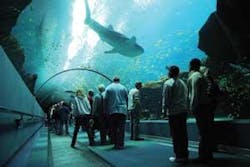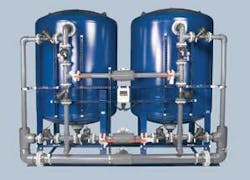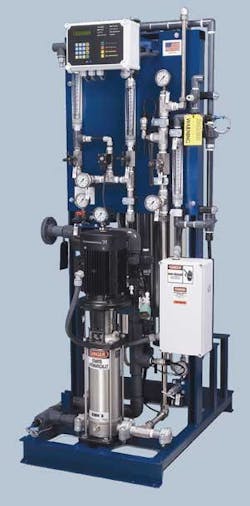Fishy, But Not Dirty
High-purity water equipment and service ensures clean water at the Georgia Aquarium, which employs industrial-sized systems to make the largest U.S. indoor exhibit of fish livable for thousands of creatures for which it’s home.
Aquarium fish need many things to survive – clean water chief among them. The Georgia Aquarium in Atlanta, one of the world’s largest, required clean water for the over 100,000 animals and fish that live there. Incoming water had to be treated before it could be used in the salt and freshwater exhibits.
Freshwater Experience
The aquarium chose Siemens Water Technologies to supply specialized high-purity water treatment equipment to remove chlorine, dissolved minerals and organics from the main facility’s incoming water and the make-up water for all the freshwater exhibits. Siemens became involved in the project during the equipment layout phase, providing temporary water systems that could be used for research and for housing the animals and fish while the main aquarium was being built. It worked closely with the aquarium’s director of plant engineering, the building’s architect and mechanical contractor on the permanent equipment for the main facility.
Carbon & RO
Aquarium operators subsequently purchased two very large carbon towers from Siemens to treat the city water coming into the building. The towers were specifically sized to meet the facility’s stringent water chemistry requirements, since that water would be used to supply the tanks inside the building, and would eventually supply the five-million-gallon main saltwater tank. Also purchased were reverse osmosis (RO) systems for treating the water used in some freshwater tanks and for salt water makeup. The RO systems include water storage capability and several recirculating loops to keep the water at optimum quality. Several smaller filter housings are on the platform overlooking the reef exhibit. These filters help maintain the faithful recreation of a tropical coral reef by preserving clarity and removing organics.
A service agreement for the water treatment equipment ensures optimal performance. A technician from the local Siemens branch visits the site quarterly to verify that the RO systems and carbon towers are operating at peak performance, and to make any necessary adjustments.
Conclusion
The high-purity water treatment equipment has continuously met the water quality requirements, and the aquarium staff is very pleased with the overall performance. The RO has exceeded expectations in removing phosphate, thus resulting in water clarity and overall health of the animals and fish. This has saved the aquarium money in maintenance costs, since fewer gallons of new water are required for processing.
Siemens Water Technologies, a unit of Siemens A.G., is based in Warrendale, PA. Contact: 866-926-8420 or www.industry.siemens.com/water/
Georgia Aquarium
FYI
- When did the aquarium open? Containing over eight million gallons of water in 60 habitats, it opened Nov. 23, 2005, with a 270-day pump and filter upgrade begun in late 2006.
- How many pipes are used? There are more than 61 miles of pipes in the aquarium, enough to encircle the city of Atlanta on the I-285 loop.
- How much water is in the coral reef exhibit? It holds 164,000 gallons and is the largest living coral reef exhibit in any U.S. aquarium.
- How large is the Ocean Voyager exhibit? The exhibit contains 6.3 million gallons of water. At its longest, widest and deepest, it measures 284’ long x 126’ wide x 30’ deep, allowing even the largest fish to swim long distances before having to turn around. It houses thousands of fish including whale sharks, zebra sharks, sawfish, leopard whiprays, bowmouth guitarfish, humphead wrasses and schools of tarpon, pompano and cownose rays – just to name a few.
- How long does it take to completely cycle the water in the Ocean Voyager exhibit? Life support systems can cycle all 6.3 million gallons in the exhibit in 60 minutes.
- What else is included in the aquarium’s life support systems? There are 234 pumps using 4,560 horsepower to move 275,000 gpm of water through 157 sand filters, 78 protein skimmers and 68 towers. The aquarium has 725 times the filtration power per minute than the average swimming pool pump. The skimmers simulate a process found in nature used to rid the water of waste, whereby air bubbles formed by crashing waves carry waste out of the water on the surface tension of the bubbles.
- How is the system controlled? There are 3,000 alarm points that can make 150 million decisions per second through 11 computers. A secure wireless system allows aquarium technicians to be paged automatically to alert them to any trouble as well aadjust control valves and flow from anywhere in the building.
- What about water conservation? Due to operational changes within the life support systems, the aquarium will save about 4.5 million gallons per year during exhibit cleaning. All exhibits are closed loop systems in which the water is filtered, treated as required and largely returned to the exhibit.
- How much salt does it take to make the Ocean Voyager exhibit salty? It took 1.8 million pounds of sea salt to make the largest exhibit as salty as the ocean.
- What is the temperature in the Ocean Voyager exhibit? The water temperature is maintained at a constant 78°F by state-of-the-art heating and cooling systems.
- What is the temperature of the water in the beluga exhibit? The water is kept at 55°F.
[SOURCE: www.georgiaaquarium.org]




